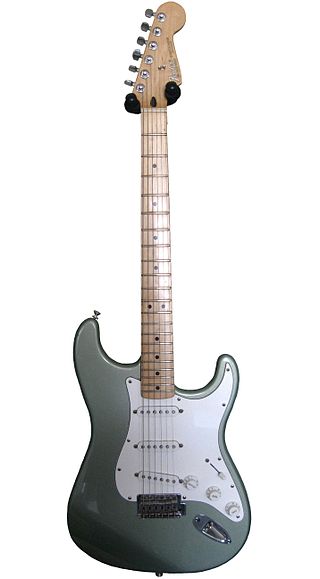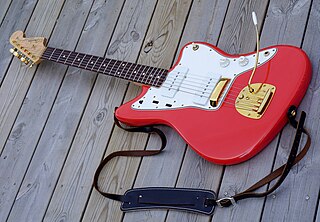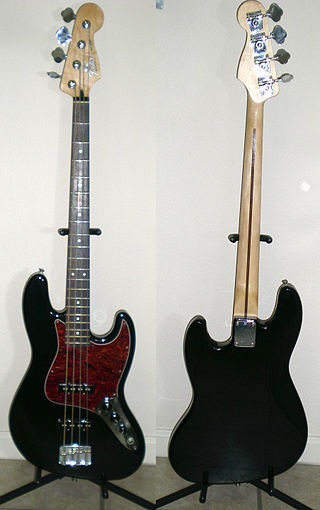Related Research Articles

The Fender Stratocaster, colloquially known as the Strat, is a model of electric guitar designed between 1952 and 1954 by Leo Fender, Bill Carson, George Fullerton, and Freddie Tavares. The Fender Musical Instruments Corporation has continuously manufactured the Stratocaster since 1954. It is a double-cutaway guitar, with an extended top "horn" shape for balance. Along with the Gibson Les Paul, Gibson SG, and Fender Telecaster, it is one of the most-often emulated electric guitar shapes. "Stratocaster" and "Strat" are trademark terms belonging to Fender. Guitars that duplicate the Stratocaster by other manufacturers are sometimes called S-Type or ST-type guitars.

The Fender Jazzmaster is an electric guitar designed as a more expensive sibling of the Fender Stratocaster. First introduced at the 1958 NAMM Convention, it was initially marketed to jazz guitarists, but found favor among surf rock guitarists in the early 1960s. Its appearance is similar to the Jaguar, though it is tonally and physically different in many technical ways, including pickup design, scale length and controls.

The Fender Showmaster is a discontinued model of electric guitar made by Fender, and is characteristic of a superstrat. Also see the badge change of Stagemaster due to legal reasons.
The Fender Jaguar is an electric guitar by Fender Musical Instruments characterized by an offset-waist body, a relatively unusual switching system with two separate circuits for lead and rhythm, and a short-scale 24" neck. Owing some roots to the Jazzmaster, it was introduced in 1962 as Fender's feature-laden top-of-the-line model, designed to lure players from Gibson. During its initial 13-year production run, the Jaguar did not sell as well as the less expensive Stratocaster and Telecaster, and achieved its most noticeable popularity in the surf music scene. After the Jaguar was taken out of production in 1975, vintage Jaguars became popular first with American punk rock players, and then more so during the alternative rock, shoegazing and indie rock movements of the 1980s and 1990s. Fender began making a version in Japan in the mid-1980s, and then introduced a USA-made reissue in 1999. Since then, Fender has made a variety of Jaguars in America, Mexico, Indonesia and China under both the Fender and Squier labels. Original vintage Jaguars sell for many times their original price.

The Fender Precision Bass is a model of electric bass guitar manufactured by Fender Musical Instruments Corporation. In its standard, post-1957 configuration, the Precision Bass is a solid body, four-stringed instrument usually equipped with a single split-coil humbucking pickup and a one-piece, 20-fret maple neck with rosewood or maple fingerboard.

The Fender Jazz Bass is the second model of electric bass created by Leo Fender. It is distinct from the Precision Bass in that its tone is brighter and richer in the midrange and treble with less emphasis on the fundamental frequency. The body shape is also different from the Precision Bass, in that the Precision Bass has a symmetrical lower bout on the body, designed after the Telecaster and Stratocaster lines of guitars, while the Jazz Bass has an offset lower bout, mimicking the design aesthetic of the Jaguar and Jazzmaster guitars.
The Fender Bass VI, originally known as the Fender VI, is a six-string electric bass guitar made by Fender.

The Fender Mustang is a solid body electric guitar produced by the Fender Musical Instruments Corporation. It was introduced in 1964 as the basis of a major redesign of Fender's student models, the Musicmaster and Duo-Sonic. It was produced until 1982 and reissued in 1990.

The Fender Eric Clapton Stratocaster is the signature model electric guitar of English guitarist Eric Clapton. It was the first signature model guitar released by Fender.

The Fender Esquire is a solid-body electric guitar manufactured by Fender. The Esquire was the first solid-body guitar sold by Fender, debuting in 1950. Shortly after its introduction, a two-pickup version was built. It was soon renamed the Broadcaster later that year; the single pickup version retained the Esquire name. The Gretsch Company at the time marketed a drum set under the 'Broadkaster' name, and at their request, Fender dropped the Broadcaster name, eventually renaming their guitar the "Telecaster". The more versatile Broadcaster/Telecaster has since become one of Fender's most popular models with dozens of variations produced. Once the Telecaster was introduced, the Esquire became marketed as a lower-cost version. Over the following two decades, the availability of other low-cost models saw the Esquire's sales decline and the model was discontinued in 1969.
The Fender Lead Series was produced by the Fender/Rogers/Rhodes Division of CBS Musical Instruments. The series comprised Lead I, Lead II, Lead III and Lead Bass models.

The Squier '51 is an electric guitar made by Squier, a subsidiary of Fender. The '51 is notable for being one of the few original designs made by Squier, which normally manufactures less expensive authorized copies of Fender's popular guitars and bass guitars.

The Fender Jaguar Bass is an electric bass guitar currently manufactured in Mexico by the Fender Musical Instruments Corporation.

The Gibson L6-S is a solid body electric guitar. It was the descendant of the L5S jazz solid-body electric guitar. It was the same shape, very much like a wide Gibson Les Paul, but with a 24-fret neck, the first Gibson guitar to have this.
The Fender Bullet was an electric guitar originally designed by John Page and manufactured and marketed by the Fender Musical Instruments Corporation. It was first introduced as a line of "student" guitars to replace the outgoing Mustang and Musicmaster models.
Fender California Series electric guitars were produced by Fender in 1997 and 1998. The guitars were carved in California, shipped to Baja California Norte, Ensenada, Mexico for painting, then assembled in California.
The James Burton Telecaster is a Signature/Artist Series electric guitar made by Fender Musical Instruments Corporation. The guitar is available in two models, Upgrade and Standard, and both were designed by American country-rock guitarist James Burton along with Dan Smith at Fender. Both models are patterned after mid-century Fender Telecaster guitars played by Burton during his long career with Ricky Nelson, Elvis Presley, Merle Haggard, Emmylou Harris, John Denver and many other well-known artists.
The Fender American Deluxe Series was a line of electric guitars and basses introduced by Fender in 1995 and discontinued in 2016. It was upgraded in 2004 and 2010 before being replaced by the American Elite series in 2016.
The Fender Elite Stratocaster is an electric solid body guitar that was manufactured by Fender in 1983 and 1984. The name was revived from 2016 to 2019 with the Fender American Elite Stratocaster Series.
The Fender Telecaster, colloquially known as the Tele, is an electric guitar produced by Fender. Together with its sister model the Esquire, it was the world's first mass-produced, commercially successful solid-body electric guitar. Its simple yet effective design and revolutionary sound broke ground and set trends in electric guitar manufacturing and popular music.
References
- ↑ "- YouTube". YouTube .
- ↑ Driscoll, Edward; Dan Forte (April 2004). "The Parsons-White String Bender". Vintage Guitar Magazine. 18 (6). Retrieved 2009-01-17.
- ↑ "American Standard B-Bender Telecaster". 1996-11-01. Archived from the original on 1997-02-20. Retrieved 2009-02-19.
- ↑ "Nashville B-Bender Tele". Internet Archive Wayback Machine. 1998-12-03. Archived from the original on 1998-12-03. Retrieved 2009-02-19.
- ↑ "American Nashville B-Bender Telecaster". Fender. Archived from the original on 2006-10-22. Retrieved 2009-01-12.
- ↑ Dan Forte (April 2009). "Fender Nashville B-Bender Telecaster". 3220 Publishing, Inc. Archived from the original on 2009-10-07. Retrieved 2009-09-25.
{{cite journal}}: Cite journal requires|journal=(help)